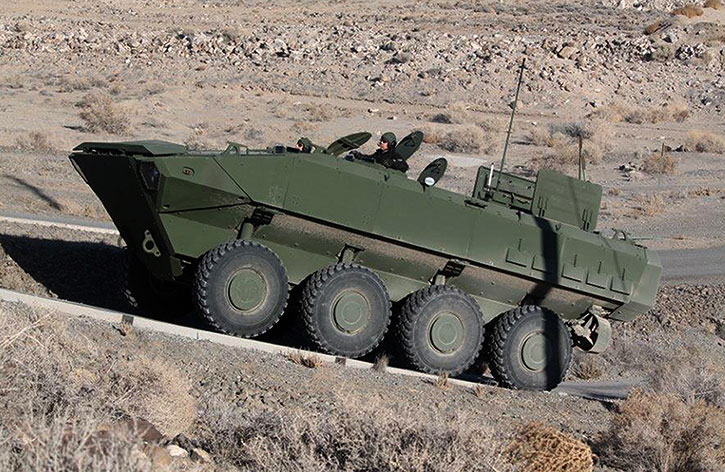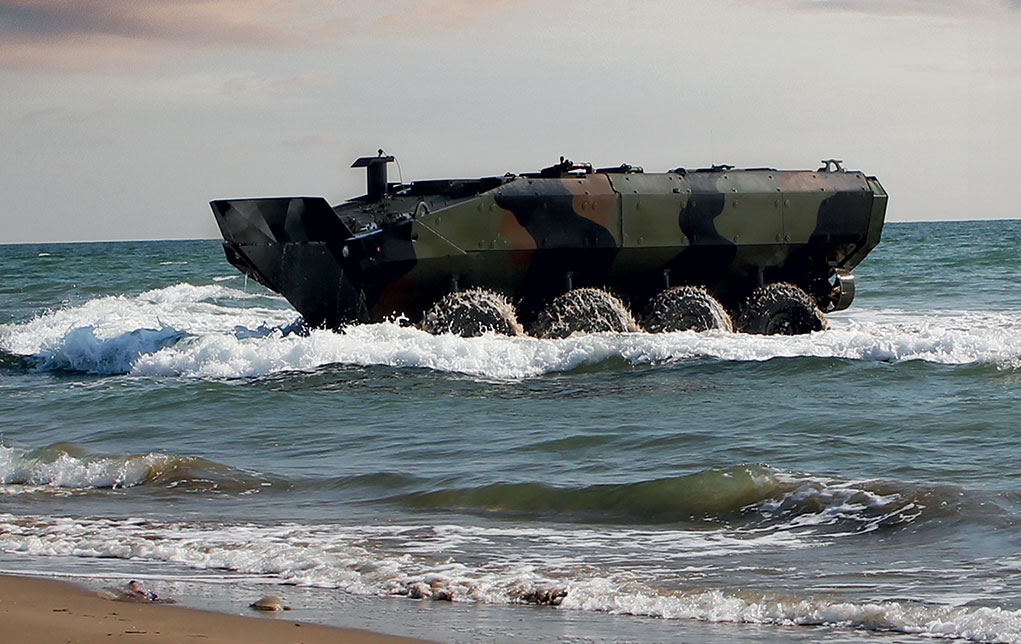The U.S. Marine Corps has selected a new wheeled, amphibious combat vehicle (ACV) for the service. Following a successful Milestone C decision by the Assistant Secretary of the Navy for Research, Development, and Acquisition, the contract options worth $198 million will allow BAE Systems to build 30 low rate production vehicles, which will start delivering in the fall of next year. These vehicles will begin the transition of a portion of the Assault Amphibious Vehicle fleet. [wlm_ismember]Under this program, the Navy awarded BAE Systems a $198 million contract to deliver the initial 30 vehicles, with options for additional 174 vehicles, what could lead up to a $1.2 billion procurement. [/wlm_ismember]The new vehicle designated ACV 1.1 by the Corps is an advanced 8×8 open ocean-capable vehicle that is equipped with a new 6-cylinder, 700HP engine, which provides a significant power increase over the tracked LTVP-7A Assault Amphibious Vehicle (AAV), which is currently in service and has been in operation for decades.

Based on the Italian SuperAV design introduced by Iveco Defense Vehicles, ACV provides exceptional mobility in all terrains, a suspended interior seat structure for 13 embarked Marines, blast-mitigating positions for a crew of three, and improved survivability and force protection over currently fielded systems. The team has conducted extensive risk mitigation testing and evaluation for water operations, land mobility, and survivability that have proven the solution’s capabilities. The design is adaptable to accommodate growth for future technologies or requirements.
[wlm_ismember]Four of the LRIP vehicles are set for destructive testing, and the balance will move out to operational Marines as quickly as possible to start a long-stalled effort to replace the 870 1970s-era Amphibious Assault Vehicles the service has struggled to maintain in the inventory. PEO Land Systems anticipates an initial operating capability in the second quarter of Fiscal Year 2020, with a full-rate production decision later that year. USNI wrote.
The Marines have already identified the 3rd Assault Amphibian Battalion within I Marine Expeditionary Force, based in Camp Pendleton, Calif., as the first unit to swap their AAVs for the new ACVs. Fielding should begin in the fourth quarter of 2020, with full operational capability scheduled for 2023, according to a Marine Corps news release.
The contest for ACV was born after the Marines canceled the Expeditionary Fighting Vehicle program in 2011, after investing more than $3 billion in development for an armored amphibious carrier that could travel up to 20 knots from an amphibious warship to the beach. After than high-speed swim capability proved too costly and too challenging, the Marines instead elected to develop an incremental approach to replacing the AAVs by fielding this ACV 1.1 variant now and considering high-speed swim and other capabilities as potential future upgrades. The Marine Corps also prioritized having a constant conversation internally and with industry on what the service needed for the replacement based on available designs.[/wlm_ismember]
Iveco Defence Vehicles and BAE Systems teamed together in the very early phases of this program to offer a superior solution to the US Marines for their ACV requirement. The team has already built 16 prototypes of the vehicle, as part of the Marine Corps competition for the next generation of vehicles to get the Marines from ship to shore to engage in land combat operations. BAE Systems will be the prime contractor for the program with CNH Industrial subsidiary Iveco Defence Vehicles providing the 8×8 amphibious armored platform design, core components, and services. Work on the program will be performed at the company’s facilities in Aiken, South Carolina; Sterling Heights, Michigan; Minneapolis; Stafford; San Jose, California; and York, Pennsylvania.
The BAE Systems team conducted its own extensive risk mitigation testing and evaluation for land mobility, survivability, and swim capabilities that proved its vehicle’s performance prior to delivering the first 16 prototypes to the Marine Corps in 2017. this delivery was part of service’s evaluation process, where BAE and SAIC built 16 prototypes each for extensive testing before the final award that was announced yesterday. Over the past 15 months, the company supported the Marine Corps’ rigorous Developmental Testing and Operational Assessment of the vehicles, which performed superbly in water and land operations, payload, and survivability.
[wlm_nonmember]This 518-word article is part of the 747-word article open to subscribers.[/wlm_nonmember]





















